P&O
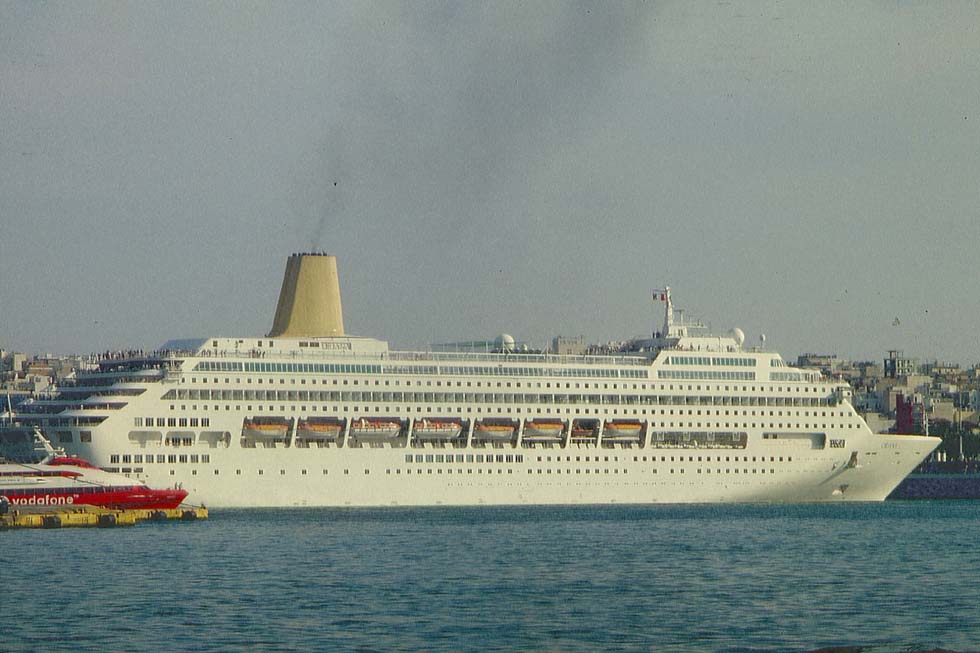
The “Oriana” of 1995, Piraeus 2004 (WS)
P&O Cruises
The Peninsular & Oriental or P&O, once much bigger than Cunard, used its last ocean liners for P&O Cruises. The round-the-world sailings of the flagship “Canberra” (45,733 gt) and the “Oriana” (41,915 gt) represented the pride of the P&O. Some tradition of its subsidiary British India Line, once almost as famous, survived for some time with BI Discovery Cruises, offering in the ‘70s Mediterranean cruises with the “Uganda” (17,000 gt), originally a British India liner, which finally was scrapped in 1986.
The most important change had come in 1974, when P&O bought Los Angeles-based Princess Cruises, a newcomer which soon became much bigger than its parent company – see chapter Princess Cruises. About that time, P&O acquired vessels from Norwegian Cruiseships A/S. Together with the purchased ships, also P&O’s “Spirit of London” (1972/17,370 gt), which had been commissioned by Klosters Rederi as “Seaward”, was transferred to Princess Cruises, becoming the “Sun Princess” (and in 1995 the “Southern Cross”, chartered by CTC, then cruising under various Flamenco names, in 2008 arrested at Singapore).
A danger was warded off when “P&O appointed Jeffrey Sterling as chairman to fend off an unwanted takeover bid by Cunard Line’s owners Trafalgar House…” (Douglas Ward: Berlitz Complete Guide…). The next big change came in 1988 with acquisition of Sitmar Cruises by P&O (see chapter End of Liners / Italy). P&O transferred that fleet mainly to Princess Cruises and dropped the renowned label.
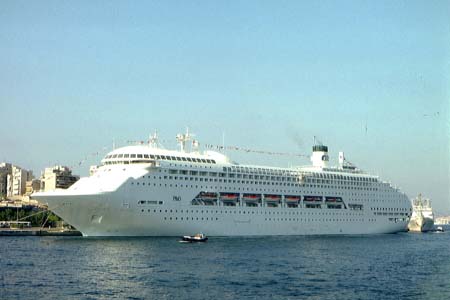
“Crown Princess”, originally commissioned by Sitmar, Piraeus 1990 (WS)
|
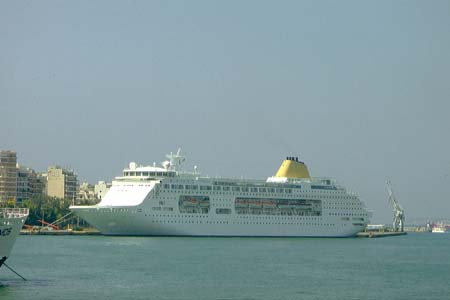
“Arcadia”, commissioned as “Sitmar Fair Majesty”, Piraeus 2001 (WS)
|
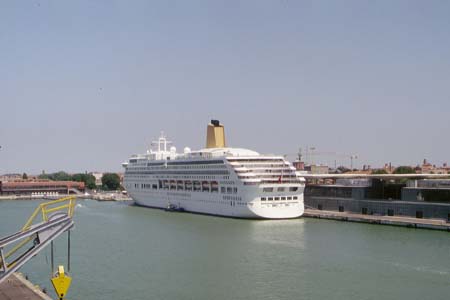
“Aurora” of 2000, Venice 2011 (WS)
|
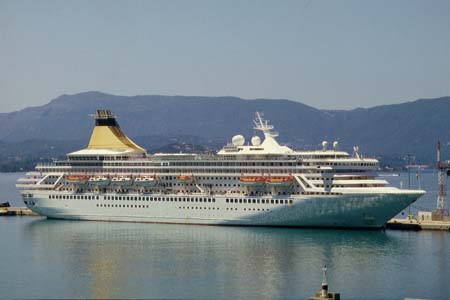
“Artemis”, ex “Royal Princess”, Corfu 2007 (WS)
|
P&O’s traditional “Oriana” was sold in 1986 to become a tourist center in the Beppu Bay in Kyushu, where she sank in 2004. A new “Oriana” (69,153 gt), built by Meyer Werft and baptized by Queen Elizabeth II in 1995, continued the tradition of prestigious P&O ships. In 1997 P&O took out of service their beloved “Canberra”, justified by SOLAS regulations. Preservation schemes had no success. She was replaced by the “Arcadia” (63,524 gt), originally launched as “Sitmar Fairmajesty”, later operating for Princess Cruises as “Star Princess”. True successor of the “Canberra” however became the “Aurora”, with her classic appearance fairly similar to the “Oriana”, but with 76,152 gt larger, delivered by Meyer Werft in 2000.
A festive event was the millennium cruise round Africa, undertaken by the “Victoria” (1966/ 28,891 gt), the former “Kungsholm” (IV) of Svenska Amerika Linjen, from 1979 the “Sea Princess” of Princess Cruises. For that occasion her funnel was painted in the colours of the traditional Union Castle Line. In 2002 she became the “Mona Lisa”, cruising for Holiday Kreuzfahrten, her funnel now being decorated with world’s most famous portrait.
In April 2003 P&O Cruises, including Princess Cruises, was acquired by the Carnival Corporation. That biggest deal in the cruise business was described by Welt am Sonntag (20 Feb. 2005): “The decisive battle for dominating the market was won by Arison not before 2003, when he cut out his mightiest competitor Royal Caribbean during a two years’ struggle for taking over P&O Princess. After he had offered 8.2 billion dollars, P&O Princess became owned by Carnival …” P&O Cruises was put under the command of much bigger Princess Cruises, but retained identity and brand name.
Several times ships changed between Princess Cruises and P&O. In 2002 the “Ocean Princess” (77,499 gt) of the Sun class was transferred to P&O Cruises as “Oceana” and for a short period also her sister “Sea Princess” as “Adonia”. In 2005 followed the smaller “Royal Princess”, (1984/ 44,588 gt), renamed “Artemis”. And the series of changes continued.
In 2005 the “Arcadia” (IV) was put in service. That’s the 82,972-ton ship of the HAL Vista class, with diesel plus gas-turbo-electric engines and 2 pods, which initially should have become Cunard’s “Queen Victoria”, now equipped with the buff P&O funnel. In 2008 Fincantieri delivered P&O’s biggest ship, the “Ventura”, followed by the “Azzura”, based on the extended Grand class of Princess Cruises, the ‘Princess’ funnel being painted buff. In June 2011 Lloyd’s List reported a contract with Fincantieri for an $805million newbuild for 3,600 passengers, to be delivered in 2015. The interior design is by Richmond International from England. With this “Britannia”, P&O entered a new size, like Princess Cruises with the rather similar Royal class. And with around-the-world tours, P&O maintained British tradition with Indian staff.
Newbuilds for delivery from 2005:
Based on HAL Vista class
Fincantieri, diesel plus gas-turbo-el., 2 pods: “Arcadia” (2005/ 86,799 gt).
Based on extended Grand class
Fincantieri: “Ventura” (2008/ 116,017 gt), “Azura” (2010).
141,000-ton class
Fincantieri: “Britannia” (2015/ 141,500 gt)
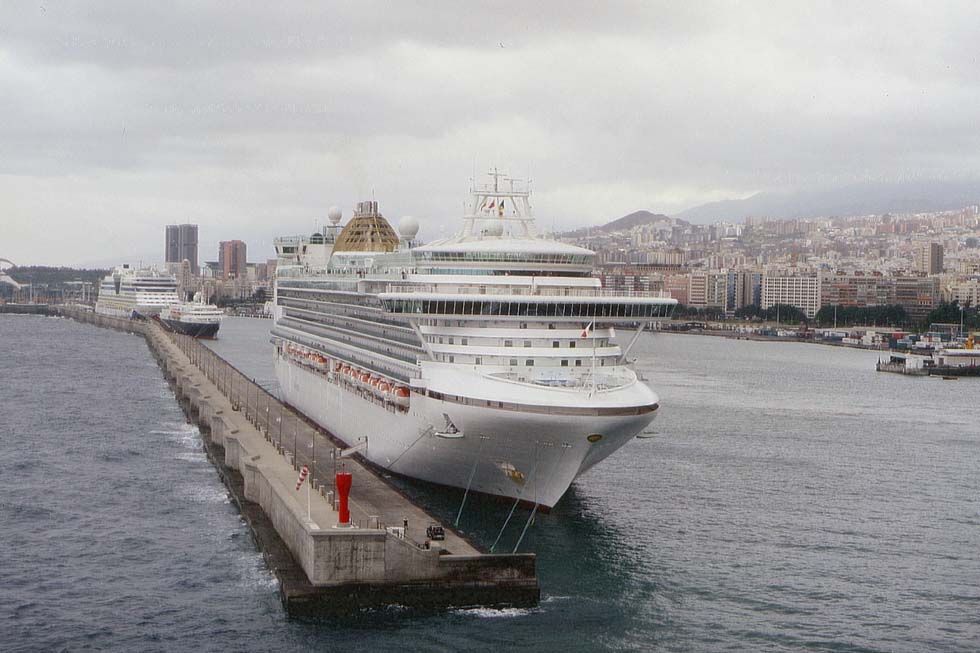
“Ventura” of P&O, in the background “Minerva” and “AIDAluna”, Santa Cruz, Tenerife 2010 (WS)
P&O Cruises (Australia)
About the origins, Ships Monthly (April 2007) informed: “Sitmar placed “Fairstar” in year-round cruise service in Australia in 1974. Over the next 23 years, she developed a loyal following and was the only ship based year-round in these waters until sold to scrappers in 1997”. In 1979 the “Sea Princess”, the former “Kungsholm” (IV) had her first departure from Sydney. From 2002 the “Pacific Princess” (30,277 gt, ex “R Three”) cruised temporarily out of Sydney. In 2004 the “Pacific Sun” (47,262 gt, the former “Jubilee” of Carnival) and in 2005 the “Pacific Star” (36,674 gt, originally the “Tropicale” of Carnival, now with a strait funnel) was taken over. One by one the old ships were given away. In 2007 the first “Pacific Sky” (46,087 gt, ex “Sky Princess”) was replaced by the “Pacific Dawn” (1991/70,285 gt, ex “Regal Princess”), one of the two beautiful ships commissioned by Sitmar, the superstructure designed by star architect Renzo Piano. Further changes of second-hand ships continued. With another paint scheme, P&O Cruises (Australia) distinguished itself from P&O Cruises (UK).
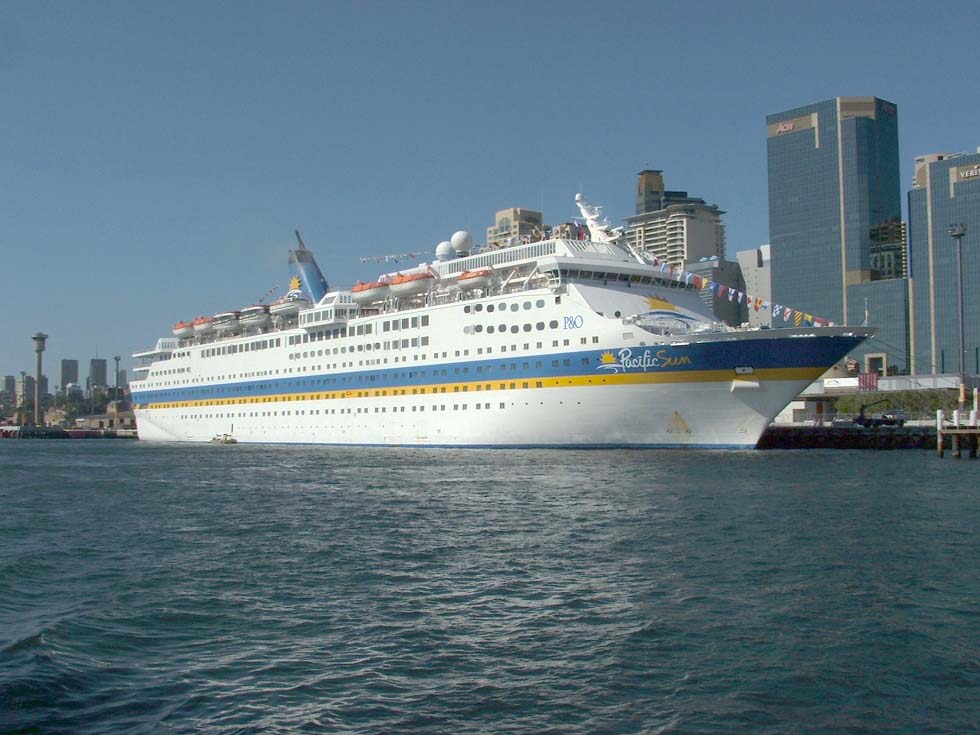
“Pacific Sun”, Sydney 2006 (Saberwyu, via Wikimedia)
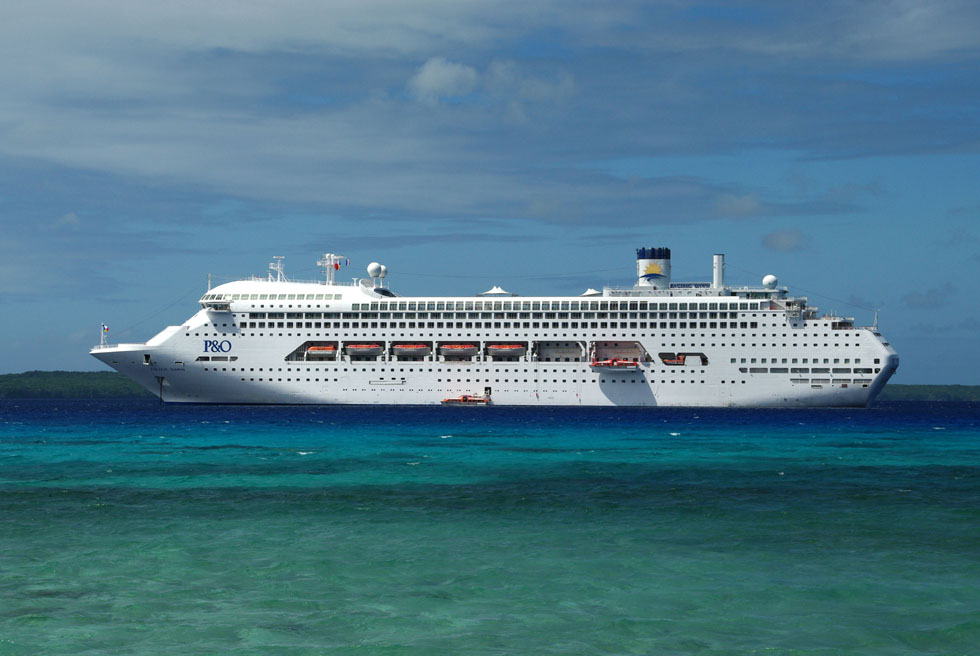
“Pacific Dawn” ex “Regal Princess”, Baie du Santal, New Caledonia 2009 (Pilettes, via Wikimedia)
Swan Hellenic Cruises
In 1983 the P&O group took over that small exclusive enterprise, founded in 1961 by the Englishman W.F. Swan. From 2003 for the first time a midsize ship, the “Minerva II” (2001/ 30,277 gt, ex “R Eight”) operated under the Swan Hellenic label, but in 2007 she was transferred to Princess Cruises as “Royal Princess”. The Swan Hellenic fleet had disappeared, but the brand was acquired by Lord Sterling and then Swan Hellenic was bought by the All Leisure Group, restarting cruises with their first “Minerva” (1996/ 12,331 gt).
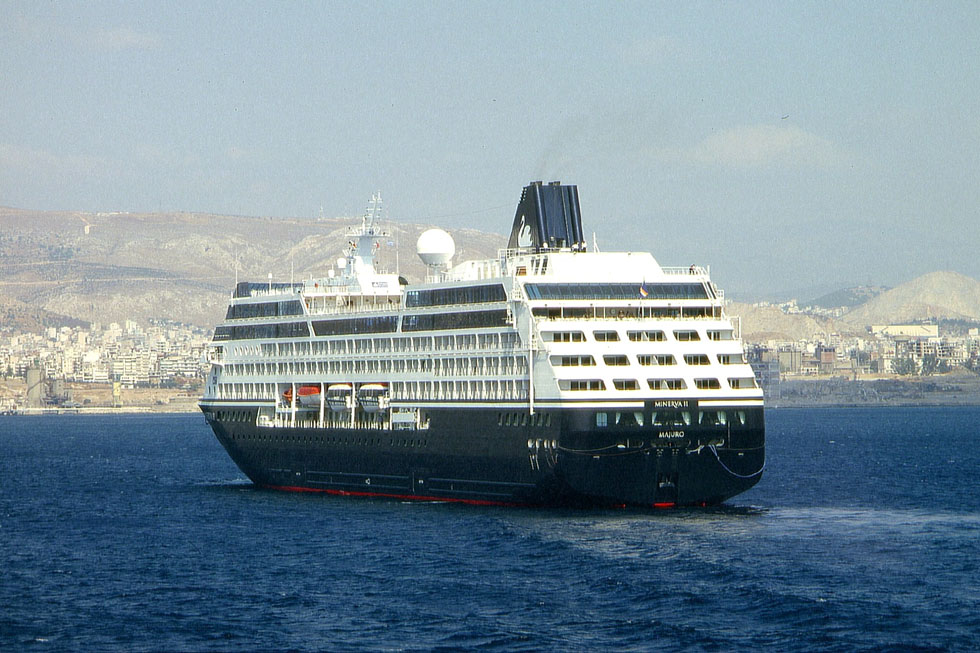
“Minerva II” of Swan Hellenic, ex “R Eight”, Piraeus 2008 (WS)
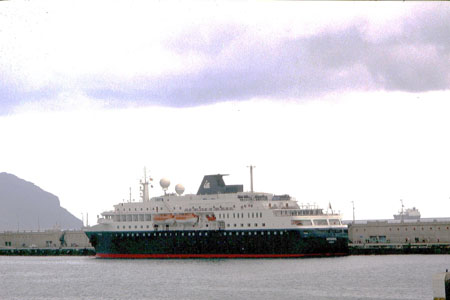 “Minerva” at Santa Cruz, Tenerife 2010 (WS)
“Minerva” at Santa Cruz, Tenerife 2010 (WS)
Ocean Village
P&O founded Ocean Village in 2003, intended to attract a younger, more casual clientele with ships painted white, colorfully decorated. The “Ocean Village” (63,524 gt, the former “Arcadia”, originally “Sitmar Fairmajesty”) started the service, in 2007 joined by the “Ocean Village Two” (ex “Crown Princess”, “A’Rosa Blu”, “AIDAblu”), one of the two 70,285 gt ships styled by Renzo Piano for Sitmar Cruises. Then it was decided to close down Ocean Village in late 2010.
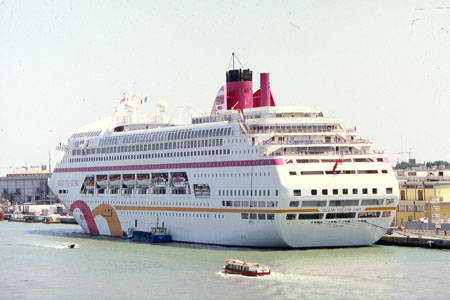 “Ocean Village Two”, Venice 2009 (WS)
“Ocean Village Two”, Venice 2009 (WS)
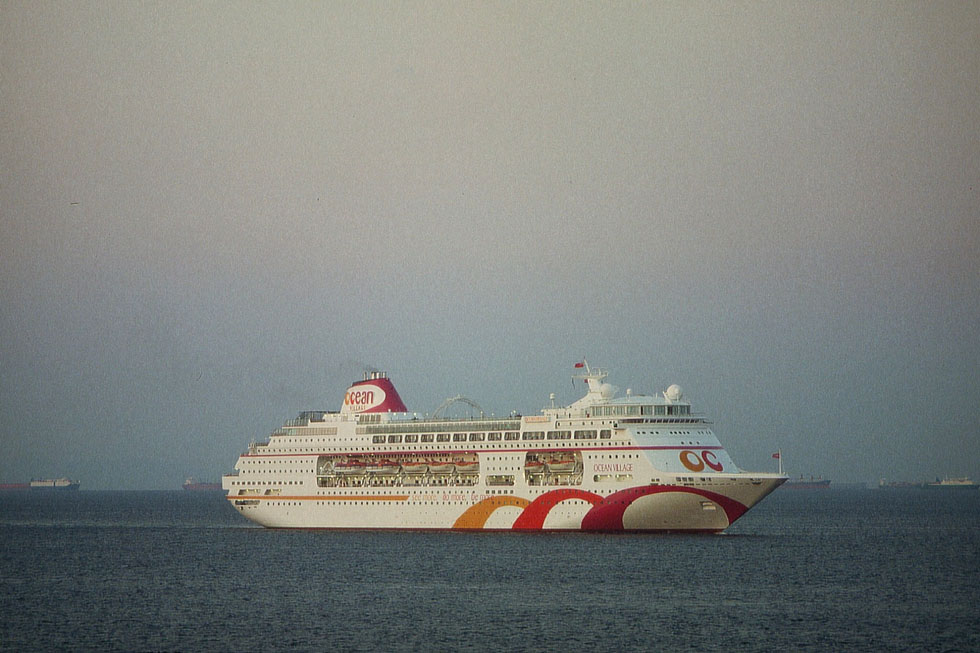
“Ocean Village” approaching Piraeus, 2008 (WS)
|